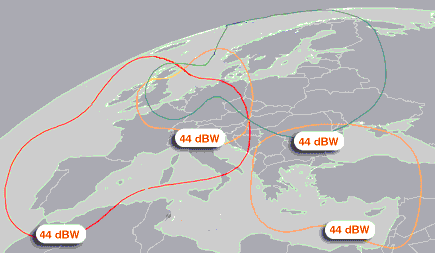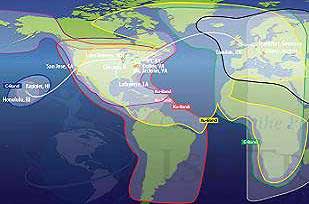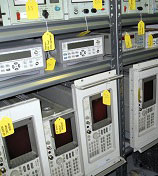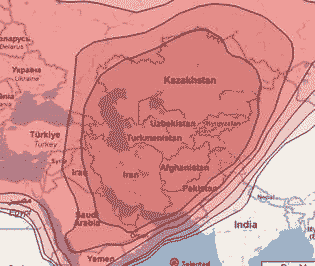Mothballed satellite sits in warehouse, waits for new life
Posted by
world Jr at Monday, March 2, 2009
Satellite Internet Service
BY STEPHEN CLARK
| The long-grounded Deep Space Climate Observatory may be revived for an assignment very different from the controversial mission that was cancelled for its infamous mix of politics and science. NASA, NOAA and the U.S. Air Force completed a comprehensive study last month to determine the feasibility of finally launching the refrigerator-sized satellite, which has been confined to a lonely corner of a Maryland warehouse for seven years. The agencies are discussing adapting the DSCOVR spacecraft for a new mission to monitor solar wind and space weather from the L1 libration point, a site 1 million miles away where the pull of gravity from the sun and Earth is equal. Although engineers say the spacecraft is healthy after its lengthy storage, DSCOVR's new plans will probably depend on NOAA's budget over the next few years. NOAA and the Air Force have already paid NASA to remove DSCOVR from its white storage crate and begin testing at Goddard Space Flight Center in Greenbelt, Md. |  The DSCOVR spacecraft as seen last month. Credit: Stephen Clark/Spaceflight Now "We have paid NASA to do a study to tell us if DSCOVR as a spacecraft is still flyable," said Gary Davis, director of the Office of Systems Development at NOAA's Satellite and Information Service. The testing began in November with the power-up of DSCOVR and a set of space environment sensors known as PlasMag. DSCOVR's Earth science instruments were not turned on. The checks are helping officials estimate the cost of revamping the satellite for a new mission and launching it on an expendable rocket. NASA delivered a report to NOAA last month outlining the results of the study, including the spacecraft's health. NOAA officials are still analyzing the assessment, an agency spokesperson said. |
A team of about 30 employees checked the satellite's systems and conducted magnetic cleanliness tests. DSCOVR's solar arrays were also successfully deployed, and engineers are currently testing the power-producing panels in a vacuum chamber at Goddard.
"The first time we opened up the spacecraft, it worked perfectly," said Joe Burt, a NASA official overseeing the testing. "It was like it had just been asleep."
The focus of the new would-be mission, which is still unnamed, would be to measure solar wind particles and their effects on the environment around Earth. PlasMag and a solar coronal mass ejection sensor would be likely payloads, but specifics have not yet been finalized.
Data from the redefined DSCOVR mission would be similar to science produced by the Advanced Composition Explorer and the Wind space observatory, which are 11 years old and 14 years old, respectively.
PlasMag would provide a 30-fold improvement in temporal resolution over ACE and Wind, according to scientists.
The solar wind data would be used for operational space weather forecasting by NOAA and the Air Force Weather Agency, according to an Air Force spokesperson.
Officials have not determined the fate of DSCOVR's Earth science instruments, but the mission's principal investigator said a decision to remove the climate instruments would be "appalling."
Francisco Valero, a researcher at the Scripps Institution of Oceanography in San Diego, still leads a team of scientists in charge of DSCOVR's original science objectives.
Valero said the cost of launching DSCOVR's full set of instruments, which includes payloads designed to monitor the solar wind, would not be much different than the cost of flying a new instrument package geared only toward space environment studies.
"The total cost of the instruments, the science, and the support that will be necessary is about 10 or 15 percent of the total cost (of the mission)," Valero said. "The lost opportunity for science and the waste of taxpayers' money are unconscionable."
The current DSCOVR study was commissioned under the Bush administration, and Valero is appealing to senior government officials in an attempt to salvage the mission's Earth science goals.
"All that needs to be done is to launch the satellite as it is now," Valero said. "Everything is on there. The solar instruments are on. The Earth science instruments are already bolted on the satellite. If they don't start working and spending money to remove things, that would be wonderful."
Valero said he hopes the Obama administration will proceed with DSCOVR as is, but key leadership positions at NASA and NOAA remain unfilled. President Obama has not named a new NASA administrator, and NOAA Administrator nominee Jane Lubchenco is still awaiting Senate confirmation.
Lubchenco declined an interview request until the confirmation process is completed, but she pledged renewed cooperation with NASA during a Senate hearing last month.
"I believe that both NOAA and NASA intend to have the best possible relationship," Lubchenco said.
NASA already handles acquisition and some management duties for NOAA weather satellites. A new DSCOVR mission would also require a strong partnership between the agencies.
President Obama's fiscal year 2010 budget outline proposed $1.3 billion for NOAA satellite programs, an increase over fiscal year 2009 levels, but more details won't be revealed until April.
If DSCOVR is chosen for implementation, the ultimate science payload would have to be balanced with funding concerns, especially the cost of a launch vehicle, according to Davis.
Managers originally wanted to use an Air Force Minotaur 5 rocket to launch the satellite, but engineers found the spacecraft would not fit on that booster.
Depending on its final mass, the spacecraft would likely fly on a Delta 2 or Falcon 9 rocket. Davis stressed those are very preliminary discussions and any final decision is months or years away.
A NASA study from 2007 concluded that DSCOVR could be refurbished, tested and launched aboard a Delta 2 rocket for about $205 million. But that estimate was based on an Earth observation mission using instruments already built.
Launch would probably occur in about 2013, officials said.
But NOAA officials must first finish examining NASA's report and decide whether to pursue the mission.
"If the numbers seem to make sense to us, and the powers-that-be think it's worthwhile, we could potentially ask for funding to do this," Davis said.
If the mission is approved, NASA would prepare the satellite for launch, the Air Force would help fund the launch, and NOAA would operate the spacecraft.
Engineers want to put the craft through a new round of environmental tests to check the satellite's response to the intense sounds, vibrations and temperature swings it would experience during flight.

Some components may have to recertified or replaced, including DSCOVR's reaction wheels, star tracker and flight battery.
"These are preliminary assessments and NOAA and NASA will develop a more definite plan if the decision is made to proceed," a NOAA spokesperson said.
NOAA began considering using DSCOVR for solar wind studies in 2007.
Space Services Inc., a Houston-based company that specializes in launching cremated remains into space, approached the government with a proposal to redevelop the spacecraft for solar observations. Space Services would have sold the data to the government.
Government and commercial organizations were unable to reach an agreement.
NASA finally acted on NOAA's suggestion last year after Congress passed the NASA Authorization Act of 2008.
The bill required NASA to submit its plans for DSCOVR to Congress 180 days after the legislation became law. That deadline is in April.
Steve Cole, a NASA spokesperson, said the congressional report is separate from the NOAA solar wind study, but the work could fulfill the obligation if NOAA chooses to go ahead with the mission.
The Obama administration's transition team also asked NASA officials about the status of the DSCOVR mission.
"NASA came back to us and asked us if we still had interest," Davis said. "We got to the point where NOAA and the Air Force could pay NASA to do this study."
Mission long stalled
DSCOVR was originally approved in October 1998 as a mission to continuously observe the sunlit side of Earth from the L1 point.
The idea was first proposed by former Vice President Al Gore during a speech at the Massachusetts Institute of Technology in March 1998. Gore's vision was for the mission to produce live imagery of the full sunlit disk of Earth 24 hours a day. The pictures were to be posted on the Internet.
Gore named the project Triana, after the sailor that first spotted land on Columbus's 1492 voyage to the Americas.
"This new satellite...will allow people around the globe to gaze at our planet as it travels in its orbit around the sun for the first time in history," Gore said in the announcement.

NASA added several instruments to Triana in an attempt to build scientific support for the mission, but the additions drove up the satellite's cost.
The higher price tag caught the attention of the agency's own inspector general. The internal watchdog issued a report in 1999, criticizing Triana's rising cost and expressing concern over the mission's scientific merit.
Triana was originally due to launch on a space shuttle mission in 2000, but Congress ordered NASA to put the project on hold in late 1999 pending a review by the National Research Council.
Congressional Republicans called the satellite an overpriced "screen saver" and criticized the mission as one of Gore's pet projects.
The council, part of the National Academy of Sciences, concluded in March 2000 that Triana was a worthwhile mission that would collect unique data with important applications in climate change research.
The group "found that the Triana mission will complement and enhance data from other missions because of the measurements obtainable at the L1 point in space," according to the report.
Triana's sensors would have measured ozone and cloud distributions, vegetation changes, atmospheric pollution, and the planet's radiation budget. The PlasMag instrument package was also included to study the solar wind.
The independent review team also noted NASA's contention that the project's primary focus was on technology demonstration instead of science.
"However, as an exploratory mission, Triana's focus is the development of new observing techniques, rather than a specific scientific investigation," the report said.
NASA explicitly described Triana's objectives as exploratory. Officials said the spacecraft would have demonstrated the potential for using L1, home to several solar observatories, as a location for Earth science.
Valero acknowledges the satellite's "innovative" observation method, but he contends DSCOVR's mission was rooted in science geared toward climate change research.
DSCOVR's Earth-pointing telescope and radiometers, still bolted to the spacecraft today, are designed to check the planet's thermostat by gauging solar radiation reaching the planet.
The radiation balance would tell scientists whether Earth is warming or cooling based on the difference in energy that is absorbed and released each year, Valero said.
Scientists already know the planet has a radiation imbalance a few times greater than the greenhouse effect of atmospheric carbon dioxide.
Valero said a deep space Earth observatory would give scientists a new way of studying the planet by facilitating continuous imagery. Other Earth observation satellites fly in low-altitude orbits and collect global data on a timescale of days.
"I am not watching, say, San Francisco, then 10 hours later, New York, and then Denver," Valero said. "I'm looking at the whole thing now."
The new paradigm demonstrated by DSCOVR would be more reliable because using low Earth orbit satellites is like "looking at the forest tree by tree," Valero said.
NASA decided to suspend work on Triana in 2001, months after former President Bush took office following his defeat of Gore in the 2000 election.
"Parts, ground support equipment and documentation were impounded and saved," Cole said.
The spacecraft was transferred to a clean room at Goddard in November 2001, where it was stored under nitrogen purge conditions until it was removed for testing last November.
Cole said earlier reports pegging the cost of DSCOVR's storage in a space age warehouse at $1 million per year were inaccurate. The real cost was closer to several thousand dollars per year, according to Cole.
Triana was renamed DSCOVR before NASA quietly cancelled the mission in 2005, citing the dwindling number of remaining shuttle flights and a lack of funding to refurbish and launch the satellite.
The cancellation came after NASA had spent $97 million on the project, Cole said.
France and Ukraine later proposed launching DSCOVR on Ariane and Tsyklon rockets, but NASA did not accept the offer, according to Valero.
The Ukrainian plan even included a free launch, Valero said.
But federal law restricts NASA payloads launching on foreign rockets.
NASA now relies on the science community for advice for new projects.
After criticism regarding the way NASA selects space and Earth science missions, officials began soliciting regular input from independent scientists.
"It's important to know that NASA is now using input from the broad Earth science community in deciding which missions to pursue in the future," Cole said.

The recommendations come from a decadal survey prepared by a committee of the National Research Council, the same group that reviewed the Triana mission in 2000.
The committee's first decadal survey was submitted in January 2007 to advise NASA on the science community's highest priorities in Earth science.
Cole said the team reviewed a number of proposed missions, but DSCOVR was not among the 17 projects recommended for execution by NASA and NOAA.
NASA also commissioned an ad-hoc science workshop in May 2007 to evaluate DSCOVR's contributions to climate science.
That group concluded that the mission would provide useful data, but "DSCOVR measurements would not fulfill the climate science requirements established in the NRC decadal survey," Cole said.
That scientific verdict led NASA to begin considering other options for DSCOVR. The NASA Authorization Act of 2008 passed last year forced the issue.
The next chapter of DSCOVR's story remains unwritten, and the spacecraft still faces more obstacles before being shot into space, but the long-forgotten satellite has not been this close to launch in more than seven years.
NASA reassembled much of DSCOVR's old team for the tests. Many engineers were not sure if they would ever work on the project again.
The workers are now waiting to hear if they will be called on to bring DSCOVR back to life again, this time for good.
"We sit and wait," Burt said. "There's no next step until we get a mandate."
source: www.spaceflightnow.com













